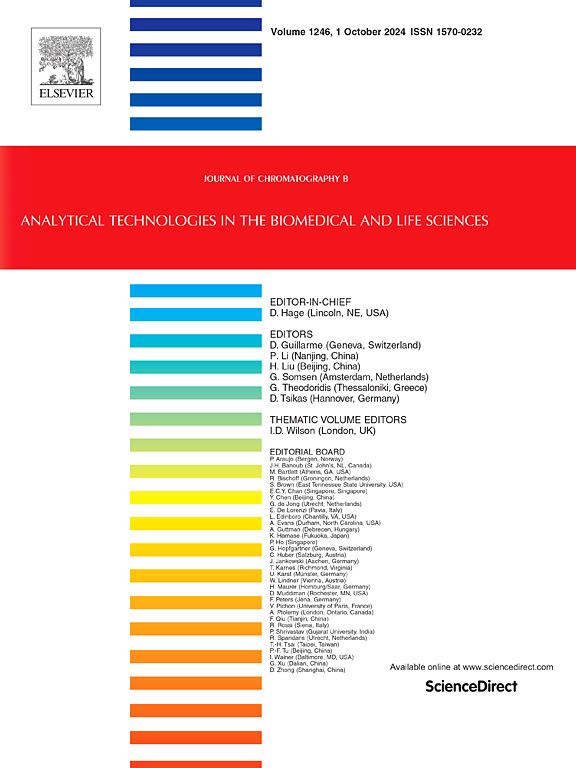Simultaneous determination of methamphetamine, MDMA, and ketamine and their metabolites in urine using a rapid and simple HS-SPME-GC–MS method: A forensic study on drug abuse patterns in South Korea
IF 2.8
3区 医学
Q2 BIOCHEMICAL RESEARCH METHODS
引用次数: 0
Abstract
The increasing abuse of stimulants such as methamphetamine (MA) and 3,4-methylenedioxy-methamphetamine (MDMA), along with the dissociative anesthetic ketamine (KET), poses a significant challenge in forensic toxicology in South Korea. To improve forensic toxicology analysis of polydrug use, a rapid and reliable method was developed for the simultaneous detection of MA, MDMA, KET, and their metabolites in urine using headspace solid-phase microextraction coupled with gas chromatography–mass spectrometry (HS-SPME-GC–MS).
The method was optimized to enhance extraction efficiency while minimizing carry-over. Validation showed excellent linearity (R2 > 0.99), acceptable limits of detection (5–20 ng/mL) and quantitation (10–50 ng/mL), satisfactory precision and accuracy. Analysis of 95 authentic urine samples revealed widespread polydrug use, with 32 of 72 MDMA- or KET-positive cases testing positive for both substances. The metabolite-to-parent drug ratio of NKET/KET was significantly higher than that of AM/MA and MDA/MDMA, suggesting faster metabolism of KET.
The validated HS-SPME-GC–MS method provides a reliable, solvent-free, and high-throughput approach for detecting MA, MDMA, and KET in forensic urine analysis. The findings highlight the prevalence of MDMA-KET co-ingestion in South Korea's club scene and emphasize the need for improved monitoring of polydrug abuse.
快速简便的HS-SPME-GC-MS同时测定尿液中甲基苯丙胺、MDMA和氯胺酮及其代谢物:韩国药物滥用模式的法医研究
甲基苯丙胺(MA)和3,4-亚甲基二氧基甲基苯丙胺(MDMA)等兴奋剂以及解离麻醉剂氯胺酮(KET)的滥用日益增加,对韩国法医毒理学提出了重大挑战。为了提高多药使用的法医毒理学分析水平,建立了顶空固相微萃取-气相色谱-质谱联用(HS-SPME-GC-MS)同时检测尿液中MA、MDMA、KET及其代谢物的方法。优化了提取方法,提高了提取效率,同时最大限度地减少了残留。验证表明线性良好(R2 >;0.99),可接受检出限(5-20 ng/mL)和定量限(10-50 ng/mL),精密度和准确度令人满意。对95份真实尿液样本的分析显示广泛使用多种药物,72例MDMA或ket阳性病例中有32例对两种物质均呈阳性。NKET/KET的代谢物与母体药物之比显著高于AM/MA和MDA/MDMA,表明KET代谢更快。经验证的HS-SPME-GC-MS方法为法医尿液分析中检测MA、MDMA和KET提供了可靠、无溶剂、高通量的方法。研究结果强调了MDMA-KET在韩国俱乐部的共同摄入的普遍性,并强调了加强对多种药物滥用监测的必要性。
本文章由计算机程序翻译,如有差异,请以英文原文为准。
求助全文
约1分钟内获得全文
求助全文
来源期刊

Journal of Chromatography B
医学-分析化学
CiteScore
5.60
自引率
3.30%
发文量
306
审稿时长
44 days
期刊介绍:
The Journal of Chromatography B publishes papers on developments in separation science relevant to biology and biomedical research including both fundamental advances and applications. Analytical techniques which may be considered include the various facets of chromatography, electrophoresis and related methods, affinity and immunoaffinity-based methodologies, hyphenated and other multi-dimensional techniques, and microanalytical approaches. The journal also considers articles reporting developments in sample preparation, detection techniques including mass spectrometry, and data handling and analysis.
Developments related to preparative separations for the isolation and purification of components of biological systems may be published, including chromatographic and electrophoretic methods, affinity separations, field flow fractionation and other preparative approaches.
Applications to the analysis of biological systems and samples will be considered when the analytical science contains a significant element of novelty, e.g. a new approach to the separation of a compound, novel combination of analytical techniques, or significantly improved analytical performance.
 求助内容:
求助内容: 应助结果提醒方式:
应助结果提醒方式:


